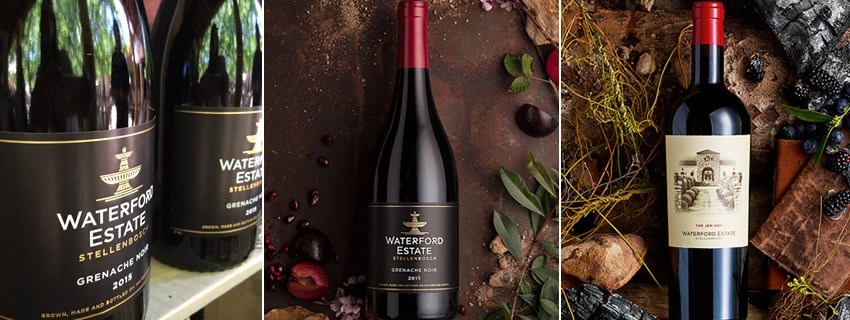Some fifty Cape wine producers now make a single varietal Grenache Noir in their portfolio – though the widely planted Spanish grape aka Garnacha comprises only 0.36% of the national vineyard in SA. Transplanted to South Australia in the late 1800's, it has flourished on its own and in Rioja and Rhône-style GSM (Grenache, Shiraz, Mourvedre) blends in hot, dry climates, reflecting its origins in Spain and southern France. Grenache is the kind of tough, drought-resistant variety the Cape needs.
The emergence of a new wave of Grenache and Mourvedre in South Australia in the 1990's earned the moniker “earth wines” – named after the distinct earthy, tobacco and savoury forest floor character of Grenache Noir and the wild, deep purple fruit and spice of Mourvedre. Australian wine writer Max Allen (“Crush”) comments, “Grenache and late-ripening Mourvedre need loads of sun to give them their essential oomph and ripe fruit flavours. This is why warmer regions such as the Barossa and McLaren Vale have done so well with these varieties for over a century”.
Grenache has popped up like a wild card at tastings in the Cape winelands in recent years. At Waterford, cellarmaster Kevin Arnold showcased bottlings of Grenache Noir and Grenache Blanc in a recent line-up of the cellar’s wines. Winemaker Mark le Roux commented, “Grenache is a variety which explores the Mediterranean side of Waterford. It grows well next to our olives. Stellenbosch Grenache is like a Pinot. Good Grenache needs older vines – these are still young at twelve years.” He says the diversity of soil types encourages experiments with different varieties like Mourvedre, Tempranillo, Barbera and Sangiovese– some of the eight varieties which go into The Jem flagship.

Grenache also made a surprise appearance at a tasting of Vriesenhof wines – tucked away among the farm’s signature Chardonnay, Pinot Noir and Kallista red blend. Cellarmaster Jan “Boland”Coetzee, a Burgundian fan to the core,quipped, “Grenache is the poor man’s Pinot Noir”. Vriesenhof was one of the early Cape producers of Grenache back in 2007. (He says Grenache was first planted at the Cape in the early 1700's.) Made from grapes sourced from old vines in Piekenierskloof near Citrusdal on the west coast, it undergoes a slow fermentation and is aged in second and third-fill oak to allow for natural expression of the variety in a velvety wine with tobacco aromas, spicy red berries and juicy fruit. (Stellenbosch) Grenache is also the lead variety in their popular GSM blend.
One of the first Cape vintages of Grenache came from the Piekenierskloof in 2002 – from the former GoueVallei cellar. The Grenache made by Tierhoek in the Piekenierskloof today from ungrafted sixty-year old vines is one of the finest examples of the variety made in South Africa. The purity of fruit, wild berry, fynbos, smoky tobacco and velvety tannins showcase this intriguing variety.
I also enjoyed the maiden release of Fides Grenache Blanc over a tasting of alternate varieties from new drought-resistant Mediterranean varieties like Sicilian Nero d’Avola and Primitivo) at Bosman Family Vineyards in Wellington. Made from old bush vines, a slow natural ferment on the skins with oxidative punch-downs, aged in old mostly Russian oak has created an “orange wine”with a creamy texture. Cellar master Corlea Fourie, who talks about “the narrative of a wine” says she made Fides like a red wine, extracting tannin and colour, to get structure and depth into the wine. She says old old vines makes the best Grenache and show a wonderful purity of fruit. There is a big demand in South Africa for new clones of Grenache to add to the gene pool of the South African vineyard. She says they found a unique mutation of Grenache in an old Moravian vineyard near Piketberg.
Grenache is a high-yield variety, producing grapes with upfront fruit – but it requires pruning and thinning to produce concentrated fruit, and older wood to make elegant wines. Although most Grenache is consumed young, when the rich, spicy fruit is at its most vivid, older Grenache wines can develop rich plummy fruit underpinned with a savoury edge – somewhat like an old Burgundy.
At a tasting of the organic wines of Waverley Hills in Tulbagh, we enjoyed the fifth vintage of the fragrant, savoury Grenache which is a best-seller in their premium range. Cellarmaster Johan Delport says young Grenache vines show in lighter styles matured in older French oak – and that the variety thrives in a hot and dry Mediterranean climate. Grenache is also the lead variety in Ken Forrester’s iconic Rhône-style blends from The Gypsy to Three Halves (SMG blend) and Renegade (SGM). Ken is a passionate proponent of Grenache – sourced from fourteen year-old vineyards he waited to mature – as well as Mourvedre, Syrah and Roussanne.

Since the release of the first Cape Grenache in 2002, some fifty cellars have released single bottlings – led by five-star frontrunners like Stellenbosch Hills – and AA Badenhorst, Adoro, Diemersdal, Fairview, Ken Forrester, Spice Route, Sadie Wines (Soldaat), The Foundry, Leeuwenkuil, Migliarina, Neil Ellis and Saronsberg. And many more. It’s incredible how many Grenache wines are sourced from the Piekenierskloof and the Swartland – and how it often plays the lead in top Rhône blends.
Grenache is growing and groovy – and may just be the Cape’s secret weapon in the battle of water-wise varieties against global warming.